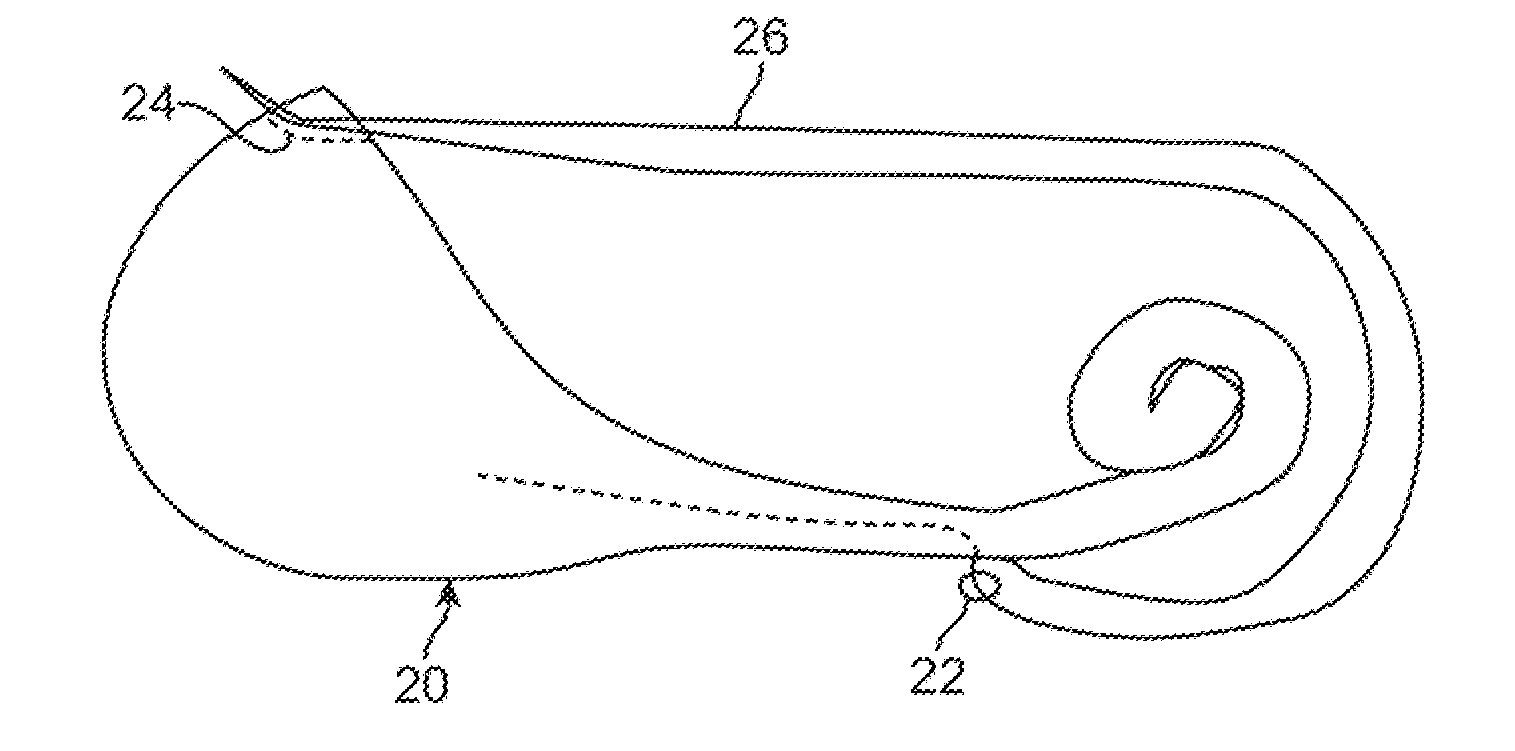Gastro-intestinal device and method for treating addiction
a gastrointestinal device and a technology for addiction, applied in the field of gastrointestinal devices for treating addiction, to achieve the effect of preventing patient tampering
- Summary
- Abstract
- Description
- Claims
- Application Information
AI Technical Summary
Benefits of technology
Problems solved by technology
Method used
Image
Examples
first embodiment
[0037]Referring first to FIGS. 1A-1C, there is shown the invention. Intragastric device 18 includes reversible member 20 that can be positioned in a patient's stomach or in other parts of the gastro-intestinal tract and that can assume an extended configuration before introduction in the stomach, as shown in FIG. 1A. Reversible member 20 can then be refolded after positioning in the stomach, as shown in FIGS. 1B and 1C.
[0038]Locking button 22 is connected to a tether and is used to force reversible member 20 to fold on itself and to maintain the folded configuration. More particularly, locking button 22 is progressively pulled through locking lumen 24 by pulling on both ends of string 26, causing locking button 22 to traverse locking lumen 24 while reversible member 20 progressively assumes a contracted, essentially spherical configuration. After locking button 22 has completely traversed locking lumen 24 and reversible member 20 is securely formed in the contracted configuration, s...
second embodiment
[0044]Referring now to FIGS. 5A-5C, there is shown the invention, in which the reversible member is a shape-memory scaffold or cage 42 that is shaped to maintain the gastric position of dispensing member 38. This embodiment may incorporate all of the features of the previously mentioned embodiment and can be inserted and extracted through an expansion and compression process of cage 42.
[0045]Cage 42 is made from or coated with a biocompatible material and expands after positioning in the stomach. More particularly, cage 42 is compressed to an elongated configuration prior to insertion in the stomach and is then disposed in the stomach with the help of positioning catheter 44. After the positioning of cage 22 is completed, catheter 44 is detached from cage 42 and withdrawn from the gastro-intestinal tract. In this embodiment, dispensing member 38 remains connected to one end of cage 42, eluting a drug or a stimulus through port 40.
third embodiment
[0046]Turning now to FIGS. 6A-6C, there is shown the invention. Intragastric device 48 includes a shape-memory and / or locking cage 46 that operates as a scaffold to maintain the gastric position of dispensing member 38. Intragastric device 48 can be inserted into and extracted from the gastro-intestinal tract by expanding and compressing age 46 and / or by locking and unlocking cage 46, to maintain the contracted configuration and to ensure that intragastric device 48 will not migrate away from the stomach and into the gastro-intestinal tract and also to ensure that dispensing member 38 does not migrate from the gastric space. Locking port 50 may be manipulated using standard endoscope tools in order to facilitate insertion and / or extraction of intragastric device 48, and, once locking is achieved, dispensing member 38 will span across diametrally opposite points on the surface of reversible member 46, with one end of dispensing member 38 reversibly engaging port 50. Cage 46 may have ...
PUM
 Login to View More
Login to View More Abstract
Description
Claims
Application Information
 Login to View More
Login to View More - R&D
- Intellectual Property
- Life Sciences
- Materials
- Tech Scout
- Unparalleled Data Quality
- Higher Quality Content
- 60% Fewer Hallucinations
Browse by: Latest US Patents, China's latest patents, Technical Efficacy Thesaurus, Application Domain, Technology Topic, Popular Technical Reports.
© 2025 PatSnap. All rights reserved.Legal|Privacy policy|Modern Slavery Act Transparency Statement|Sitemap|About US| Contact US: help@patsnap.com



